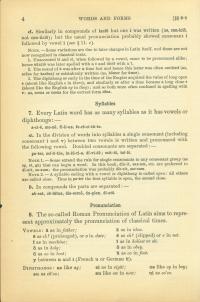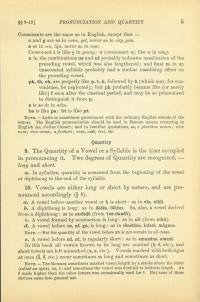8. The so-called Roman Pronunciation of Latin aims to represent approximately the pronunciation of classical times.
| VOWELS | |
| ā as in father | ă as in idea |
|
ē as eh? (prolonged) |
ĕ as eh? (clipped) or e in net |
| ī as in machine | ĭ as in holiest or sit |
| ō as in holy | ŏ as in obey |
| ū as oo in boot | ŭ as oo in foot |
|
y between u and i |
|
| DIPHTHONGS | ||
| ae like aye | ei as in eight |
oe like oy in boy |
| eu as eh'oo | au like ow in now | ui as oo'ee. |
Consonants are the same as in English, except that:
c and g are as in come, get, never as in city, gem.
s as in sea, lips, never as in ease.
Consonantal i is like y in young; v (consonantal u) like w in wing.
n in the combinations ns and nf probably indicates nasalization of the preceding vowel, which was also lengthened; and final m in an unaccented syllable probably had a similar nasalizing effect on the preceding vowel.
ph, th, ch, are properly like p, t, k, followed by h (which may, for convenience, be neglected); but ph probably became like (or nearly like) f soon after the classical period, and may be so pronounced to distinguish it from p .
z is as dz in adze.
bs is like ps; bt is like pt.
Note— Latin is sometimes pronounced with the ordinary English sounds of the letters. The English pronunciation should be used in Roman names occurring in English,
Julius Cæsar
and in familiar quotations.
e pluribus unum
viva voce
vice versa
a fortiori
veni, vidi, vici, etc.


